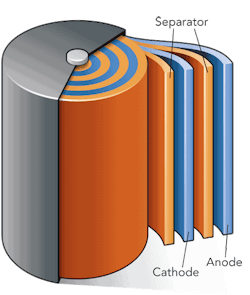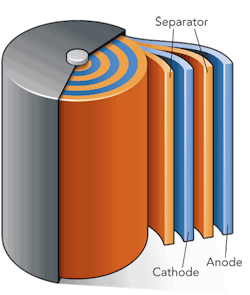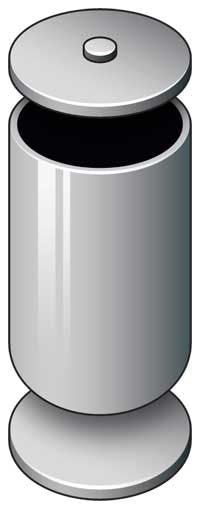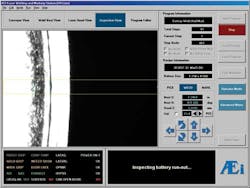Vision guided laser welding improves battery safety & performance
Applying the precision of flexible automation ensures a hermetic seal when manufacturing lithium ion batteries
Lithium ion batteries are desirable in consumer electronics due to their high storage capacity to weight ratio. They have some other characteristics that also make them eminently suitable for mobile devices: their ability to retain charge when not in use for long periods and to retain charge capacity if recharged before they are fully discharged. This is commonly referred to as "battery memory" and is a major disadvantage of other secondary batteries such as nickel metal halide.
FIGURE 1. Lithium ion batteries consist of a graphite anode, a metal oxide cathode, and a non-aqueous lithium salt as the electrolyte.
Lithium ion batteries consist of a graphite anode, a metal oxide cathode (lithium manganese, lithium cobalt, or lithium iron are commonly used), and a non-aqueous lithium salt as the electrolyte (FIGURE 1).
Safety issues
The big downside of this lithium-based technology is that lithium is explosive when in contact with air, and particularly when in contact with water. Safety concerns regarding new battery technologies have not gone unnoticed by federal authorities. Data from the United States Federal Aviation Authority show that from March 20, 1991, through August 3, 2010, batteries and battery-powered devices were involved in 113 incidents with "smoke, fire, extreme heat or explosion" on passenger and cargo planes. Of particulate concern is the fact that fires caused by lithium ion battery packaging failure are hard to put out – they are explosive when doused with water, and they can rekindle themselves on contact with air.
Despite safety concerns, the twin benefits of high capacity and low weight make lithium ion batteries extremely well suited for another application – hybrid and plug-in automobiles. However, while the safety requirements of the automotive sector have necessitated a modification to the lithium ion chemistry to make the cell less explosive, the battery's packaging still needs to be manufactured with enough integrity to survive a crash test. Other applications, such as medical, space, and deep sea applications, have even more stringent safety requirements where the environments can be hostile; a leak can be catastrophic; or replacing a faulty cell can be costly or life-threatening.
These safety factors are relevant to the manufacturing of lithium ion batteries. There are two safety concerns that manufacturers need to be concerned with: safety in manufacturing the batteries, and integrity of the product package to ensure safety in use over the life of the battery and beyond its useful life.
One of the key steps in the manufacturing process is the welding of the battery cases. The integrity of the weld must be assured to produce a battery that can withstand dropping, crash impact, heat, and pressure variations.
The processFIGURE 2. Most cylindrical or rectangular lithium ion batteries have a cap on one or both ends that require welding onto the main body. Courtesy: AEi Boston.
Lithium ion batteries come in many custom shapes and sizes, although most are either cylindrical or prismatic (rectangular). They have a cap on one or both ends that requires welding onto the main body while the graphite anode and metal oxide cathode are inside (FIGURE 2). The non-aqueous electrolyte is injected through a fill-hole once the welding is complete. It is important to understand that the battery casing sizes are only nominal. The tolerances that come with metal stamping and forming mean that sizes can vary – cylinders can be slightly elliptical rather than truly round – enough to render laser welding of the seam unreliable without machine vision.
During the manufacturing process, the anode and cathode of a lithium ion battery must not come in contact with each other, or they become a "hot cell," rapidly heating up and even igniting. Thus, the less human interaction with the cells during the manufacturing process, the better. For this reason, laser welding machines are fed battery cells, one by one, by a conveyor and through an automated "chicken coop" type door, which lets one cell in at a time into an isolating chamber.
As the battery cell moves into position, machine vision determines the height and size of the battery to match it with the automation program set up by the operator (FIGURE 3). Only then does the battery cell move into a rotary chuck. The battery rotates while high magnification machine vision tracks and logs the true path of the seam (round, elliptical, or otherwise). The motion control and machine vision program examines the actual dimensions of this particular piece-part battery, and calculates the best trajectory for the laser beam for a high integrity weld. During the weld process, the laser power is ramped up at the start and then the motion follows the calculated trajectory. It ramps back down at the end while overlapping with the start of the weld to ensure a smooth, even one.
For laser welding lithium ion batteries, AEi uses an IPG fiber laser. Fiber lasers have some significant advantages over YAG lasers, namely, greater output power efficiency, lower maintenance costs, and more control over the beam profile, cost per watt. Since there is a fair amount of individual battery handling overhead, the laser output can be time-shared between two automation machines at one time, further reducing manufacturing costs.
Once welded, the battery weld is inspected using machine vision, and the battery is laser etched with a two-dimensional barcode and fed out of the machine on the conveyor.
FIGURE 3. Machine vision tracks and FlexAuto software calculates the best trajectory for the laser beam to follow the path of the seam, ensuring a high integrity weld. Courtesy: AEi Boston.
Flexibility
The wide variety of shapes and sizes required for lithium ion battery applications does put a significant emphasis on flexibility for automation systems (FIGURE 4).
FIGURE 4. Flexible automation equipment must be able to handle a wide variety of changing battery shapes. Courtesy: AEi Boston
AEi uses a pallet-based battery loading system. Pallets handle a large range of shapes and sizes, and when new, exotic, shapes are required, only the pallet needs to be redesigned – the interface to the machine stays constant. This enables quick changeover among greatly varying battery formats on the same machine. The control software's ability to handle a wide range of formats with minimal programming is key to flexibility, too. A recipe-driven control software enables quick changeover from batch to batch, giving the manufacturer a further competitive advantage to respond quickly to changes in market conditions.
Summary
There is unprecedented growth in demand for powerful batteries fueled by traditional military and aerospace applications, as well as those called for in emerging automotive and green energy product designs. This requires batteries that meet not only the electrical specifications of the application, but also environmental and safety requirements.
The most popular solution to meet weight and electrical performance requirements are lithium ion batteries. However, lithium ion batteries have a major drawback: lithium is explosive when in contact with air and particularly when in contact with water. To gain the performance advantages of lithium ion batteries, manufacturers need to apply the precision of flexible automation utilizing high-powered lasers and machine vision to ensure a perfectly hermetic seal when manufacturing the batteries. Flexible automation supports the batteries' safe manufacturing, the robust packaging that allows the batteries to be used in various hostile environments, and the yields necessary for manufacturer profitability.
Justin Roe is the COO of Automation Engineering Inc., email [email protected].
Past ILS Issues




